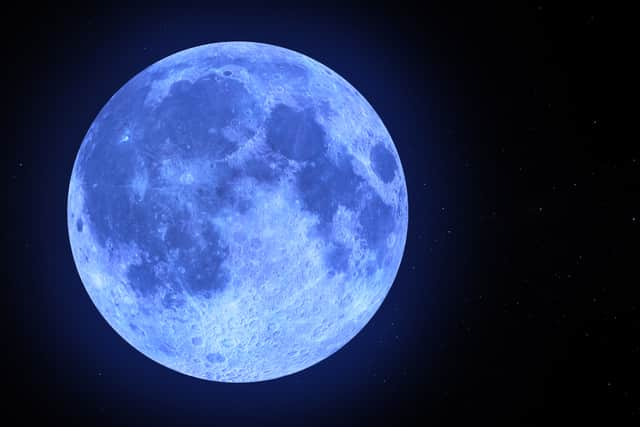Supermoon August 2023: what is a Blue Moon and when can you see it?
and live on Freeview channel 276
August will see the ninth full moon of 2023, with stargazers hoping to catch a glimpse of the mesmerising marvel.
The upcoming full moon will appear larger in the sky because it’s an example of a “supermoon”, and as the second full moon of August it is also considered a “blue moon.”
Advertisement
Hide AdAdvertisement
Hide AdHere is all you need to know about the August 2023 blue moon.
What is the Blue moon?
The next full moon falls on Thursday 31 August, reaching its peak in the UK at 2.35am, according to the Royal Observatory, Greenwich.
August is here, and will be one of the most active months for stargazers across the UK who will prepare to catch a glimpse of the Sturgeon Moon as well as the Blue Moon. These will be the eighth and ninth moons of the year.
Not only does August mark the first time a month will have two full moons, but one will be a supermoon. Royal Museums Greenwich explains how a supermoon comes to be, saying: “The distance between the Moon and the Earth varies, because the Earth is not right at the centre of the Moon’s orbit and the Moon’s orbit is not a circle (it’s an ellipse). The moment when the Moon is closest to the Earth is called a lunar perigee.
Advertisement
Hide AdAdvertisement
Hide AdThey add: “When the Moon is furthest away it is known as a lunar apogee. If the lunar perigee occurs very close to a full moon, then we see a supermoon. If a lunar apogee occurs very close to a full moon then we see a micromoon.”
The first super moon of August will be the Sturgeon moon, which will peak on August 1.
So, when will you be able to see the August super moon? Here’s everything you need to know about the celestial event.


What is the Blue moon?
The second full moon, known as a Blue Moon, will peak on Wednesday 30 August.
Advertisement
Hide AdAdvertisement
Hide AdAstronomer Professor Don Pollacco, Department of Physics, University of Warwick, comments on the Supermoon: “The first thing to remember is that planets don’t emit light of their own but reflect light from the Sun. So the planet’s hemisphere facing the Sun is always illuminated but the other hemisphere is shielded from the Sun.
“Supermoon’s are often given names which are usually of regional or historical significance – a Supermoon is August is apparently a Sturgeon Supermoon.
“As the Moon’s orbital period around the Earth is 29.5 days then two Full Moon’s are possible in a normal month. As this Full Moon first occurred early in August, then a second Full Moon can occur later the same moon. This is called a Blue Moon and gives rise to the expression we use to express rarity in events.
“To see the Full Moon, look East after Sunset. If you have a clear horizon it should be obvious. The Moon is so bright that we can see it when it’s not particularly dark or even if the weather isn’t particularly clear. It will be visible all night and set in the West around sunrise.”
Comment Guidelines
National World encourages reader discussion on our stories. User feedback, insights and back-and-forth exchanges add a rich layer of context to reporting. Please review our Community Guidelines before commenting.
